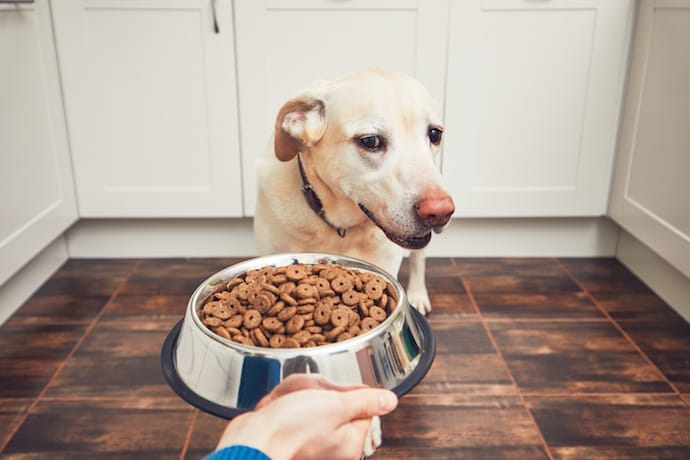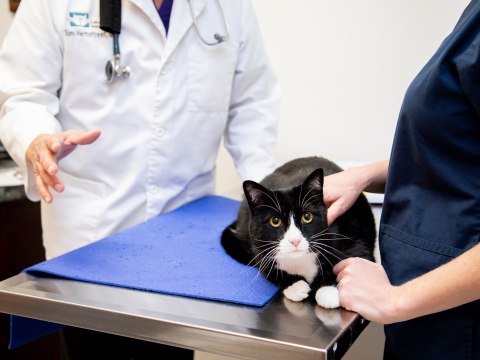Some dogs and cats are easy going and don’t mind taking their meds; however, your pet may not be happy when it comes to taking medication. Giving pills to your dog or cat can be quite stressful and challenging both for you and your fur baby. Your vet may make it look quite easy, but when you get home, things just don’t seem to work. We’ve put together some tips on how to safely give your canine or feline friend their medications.
Connect with a verified veterinarian in minutes. Licensed vets are available 24/7 to answer your questions. No need to worry about your furry family member.
Crushing Pills or Opening Capsules—Check with Your Vet
Be sure to ask your vet if it’s safe to crush pills (if necessary) or to open capsules. Some medications need to remain whole in order to work in the right way. In addition, some medications may not be safe to mix with certain ingredients. It’s a good idea to check with your vet before crushing tablets, breaking open capsules or adding liquids to your pet’s food or treats.
How to Give Your Cat a Pill
When it comes to giving pills to cats, you may be facing jaws and teeth of steel! We’ve been there and understand what you’re facing. Cats know how to use their teeth and claws very well, thank you very much!
Giving your kitty medications can be quite a challenge. As a responsible pet parent, you want to ensure she gets the medication the vet has prescribed. If your kitty doesn’t take medications easily, here’s a list of methods to try first—these are the easiest:
Hide her pill/medication in food: choose your cat’s favorite treat—it might be a type of canned cat food, canned fish, plain yogurt, cream cheese (yes, some cat’s love this!) or even butter. Make sure to keep the serving size small, as you want to make sure she eats and swallows the medication. Make sure she finishes up the entire serving. If she does, you can follow with a bit more as a treat for being a good kitty. Sometimes cat’s may taste or smell the medication in their food, and then will refuse to eat the food. It’s a good idea to use treats or foods that have a strong smell or flavor to hide the smell and taste of the medication.
Try the three-step trick: this is another method of hiding her medication in food or treats. Create three treats, putting the medication in the second treat. Make sure the treats are all the same size and shape and ensure that the medication is completely hidden in the second treat. This method sometimes works because the first treat is nothing but that—a treat. This primes your kitty for wanting another bite; this bite will have the medication hidden inside. Then she’ll want the third bite, just because the treat was so yummy!
The number of treats can vary depending on the number of pills or the amount of medication your kitty needs to take.

Review symptoms, medications & behavior to keep your pets healthy with a Vet Online in just minutes.
Ask a Vet Live NowCats Who Refuse to Take Their Medications
If your cat refuses to take her medications and if you & she are becoming quite stressed out with the whole thing, then it’s time to try some other methods.
Cat pill pockets: you might try a pet product especially made to help give cats or dogs medications. One brand called Feline Greenies Pill Pockets Cat Treats may be a good way to get your cat to take the medications she needs. These treats are shaped in such a way that you can safely hide a pill or capsule inside the treat, then pinch the treat closed. The pill pockets are made to hide the smell and taste of medications; they’re flavored with salmon or chicken—two tastes cats love. The pill or capsule now becomes a yummy treat that is more difficult for your cat to find! If your cat still manages to spit the pills out or is on a restricted diet, then you’ll have to try another method. This will mean putting the pill in her mouth and getting her to swallow it. Not an easy feat for many pet parents to manage. If you find yourself in this position, here are some considerations to keep in mind before giving your fur baby a pill:
1. Never interrupt your kitty if she’s eating, using the litter box or grooming. Never. Just take our word for it…never do this. For one thing, it’s not good manners. How would you like being interrupted during private time, bathing or using the potty just to be told to take medicine? Your cat feels the same. Plus, if you routinely do this, she will become stressed and anxious fearing you could be coming near to give her medications when she’s otherwise occupied. So, avoid interrupting your cat during these times—you’ll both be glad you waited until she was done.
2. Create a safe place to give her the medications. This could be on a table or countertop, or perhaps your lap. Choose a place where neither of you will get hurt, but that you’ll have enough control to keep her from leaving.
3. Try using the kitty burrito wrap when giving your cat medications. Have a heavy towel folded diagonally in half, so two corners come to a point at the front. Now, place kitty near the front points, but not on the points. Fold the back half of the towel toward the back of your cat’s head. Then wrap one side and then the other around her, just as if you were folding a burrito. Next, use the point at the front to gently wrap the towel under and around her chin. Only her head should be exposed—nothing else. Now, your cat will be safely contained, with all four feet wrapped, she won’t be able to dig into you, slide or jump off the surface you’ve chosen, or claw you.
4. Put a small amount of butter or margarine, or even cream cheese, on the pill or capsule. This will make it easier for kitty to swallow the pill/capsule, without it getting stuck in her throat.
5. With one hand, hold your cat’s head by putting your thumb on one side of her upper jaw and your fingers on the opposite side of her head/jaw. This will resemble a clamp holding her head. That’s OK—you want to keep her firmly in place—this will work better if she’s burrito-wrapped in a towel or blanket. Next, tilt her head back until her nose points at the ceiling. Most cats, at this point, will slightly open their mouths. This is exactly what you want.
6. With your other hand, hold the pill firmly between your index finer and thumb. Be sure to use your dominant hand for this. Now, use your little finger and/or ring finger to open your cat’s mouth by gently pressing on her lower lip and/or front teeth. Don’t use any force—gentle pressure will be enough.
7. Quickly place the pill or capsule as far back on her tongue as possible—you want to stimulate the automatic swallowing reflex. This is where putting butter or another slippery covering on the medication helps. The butter makes it easier for the pill or capsule to go down.
8. Now, hold your cat’s mouth closed and let her head return to its normal position. Here, you can also gently stroke your cat’s nose or throat, which stimulates her to swallow. You can also try blowing gently on her nose, as this has the same reaction. You can also follow the pill with a little squirt of water or meat juice (such as tuna, chicken broth, etc.). This can be safely done by using a syringe, which can you get from your vet. This just helps to make sure your cat has swallowed the medication.
9. When you’re all done, kitty will very much enjoy some love and attention for being good. Be sure to lavish her with sweet words, petting and love. This soothes her and is a great way to offer some positive reinforcement after the pill-taking sessions.
How to give a Pill to an Uncooperative Dog
When it comes to taking medications, dogs can be just as wily and difficult as cats! In some cases, you may even have to deal with a larger dog that doesn’t enjoy taking pills. We understand and have been in your shoes! Here are some creative ways to give pill to dog:
Use his favorite food or snack: again, this may work with some dogs. Foods to hide dog pills in:
choose your pup’s favorite food or snack. The smellier and the more taste it has, the better. Some dogs love liverwurst. This stuff stinks (to us) and dogs love the taste! Take a small bit of liverwurst (enough to completely wrap up the medicine), and then make sure to completely cover the pill or capsule so nothing is sticking out. And we mean nothing.
Your dog may smell the medicine or even taste it in the first bite if anything is left uncovered.
Canine pill pockets: you can also try dog pill pockets if your dog finds the medication wrapped in his favorite snack and spits it out. In fact, the same company that makes the pill pockets for cats makes them for dogs! You can try Greenies Pill Pocket Soft Dog Treats. All you have to do is simply insert the pill or capsule into the pocket treat, then pinch the end of the treat to enclose the medication. Then feed it to your dog! Most dogs will happily snarf up these treats; however, some may be able to separate the treat from the pill, in the end spitting the pill on the floor. Bummer.
Dog Refusing to Take Medication
If the first suggestions didn’t work, then we’ll have to work a little bit harder and smarter to get your pup to take his medication.
How to give a pill to a dog that bites: if your dog bites when you try to give him a pill, you might consider asking your vet if it’s possible to change the medication to a liquid form. By the way, this can also work for cats. Just as there are for us humans, there are compounding pharmacies that make pet medications. These pharmacies may be able to make a liquid form of your pup’s medication, which could make it easier to hide it in some yummy food for your pet. Ask your vet is may be possible. Keep in mind that some medications lose their effectiveness when their composition is changed (from pill to liquid) and it’s not possible to have some medications compounded. Still, it doesn’t hurt to ask the vet if this may be a viable option for your dog (or cat).
The “Pill Gun”: this is another option if all other methods fail when giving your dog (or cat) a pill. A pill gun looks something like a syringe, with a plunger on the back, and a tube on the front. The front tube will have a small device (soft silicone or something similar) that expands or opens to hold a pill or capsule. All you have to do (yah, right—we understand there are sharp teeth to deal with) is hold your pet’s head with your thumb on one side of his head and your fingers on the other side, then gently tilt his head back, apply pressure with your thumb and fingers to keep the jaw open, place the pill popper over the tongue and as far back as possible, then push the plunger. Then let your dog (or cat) close his mouth and the pill should go down OK. The pill popper gun comes in a wide variety of models, but they’re all pretty much the same. You can try this one—the Kruuse Buster Pet Pill/Tablet Syringe with Classic Tip.
We hope this guide has given you some ideas on how to get your fur baby—canine or feline—to take their medications. Keep in mind that every dog and cat is an individual—what works for one may not work with another. It may also be a good idea to use a variety of methods if your pet has to take medications over an extended period of time. Be creative, but stay safe and keep your fur baby safe and healthy in the process!
Connect with a verified veterinarian in minutes. Licensed vets are available 24/7 to answer your questions. No need to worry about your furry family member.

Kim
Kim is a talented author, who loves animals especially dogs. She engaged in writing books and articles relating to animals a decade ago. Kim resides in Chicago with her husband and son. The family is the proud owner of a dog and a parrot (Jack and Lily). Kim wanted more than these two pets, but her husband put his foot down... She often visits elementary schools to talk to the kids about what she learned about pets and how they could learn from them.
Review symptoms, medications & behavior to keep your pets healthy with a Vet Online in just minutes.
Ask a Vet Live Now



